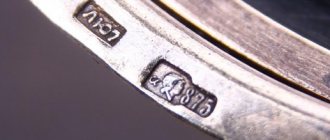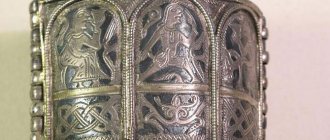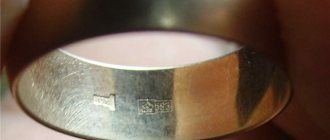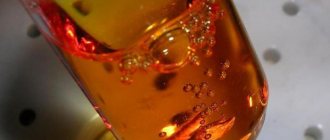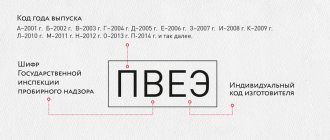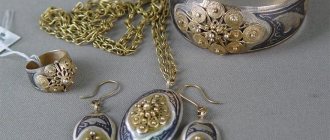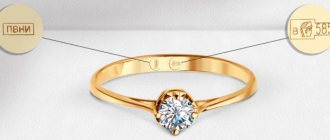Post updated: Oct 9, 2020
Very rarely gold is used in its pure form. Usually the product we call gold consists of the precious metal itself and the so-called alloy, that is, an admixture of other metals. Additives are included in the composition of gold to improve endurance and density, because gold in its pure form is very soft. Pure metal wears out quickly, and products made from it are very easy to scratch or break. High-quality products have a mark on the gold, which we will discuss later.
Even in ancient times, it was calculated that the best impurities for gold were silver and copper. Well, samples began to be used to indicate the gold content in the alloy.
Sample is the main indicator of impurities in a product, but stamps also serve this purpose - marks that are placed in control institutions and guarantee the presence of precious metal in the alloy.
In France, the first hallmark was placed in 1275, but in Russia, the first hallmark appeared on a product in Moscow in 1651-1652. It looked like a double-headed eagle with a date written in Slavic letters, and its purpose was to demonstrate the silver standard. Assays in the modern sense were introduced by Peter the Great in his decree of February 13, 1700, which established 4 assays each for gold and silver.
Gold hallmark systems
In the world there are metric, carat and spool systems for gold hallmarks. The most popular are carat and metric, of which the second is most often used. According to the British carat system, which is used in the USA, Switzerland and a number of other countries, a carat is equal to 1/24 of the mass of the entire alloy. Thus, 24 carat gold is a pure substance without additives, but 18 carat means 18 parts of gold in the total proportion of the mixture of metals. In the jewelry industry, you can most often find samples: 9, 10, 14, 18 and 24.
In Russia, since 1711, a spool sampling system has been in use for silver alloys, and in 1733 it was introduced for gold. This measure was invented on the basis of the Russian pound, which contains 96 spools, and the standard itself was expressed by the weight of gold in 96 alloy units. Pure gold had a 96 hallmark, and at the end of the 19th - early 20th centuries, the 56th, 72nd, 82nd, 92nd and 94th hallmarks were in use.
In 1927, the USSR switched to the metric calculation system; all manufactured products that previously had a spool marking changed it to metric. The new system was identical to the German one, and the sample number ranged from 0 to 1000 and demonstrated the presence of gold in the alloy.
Today, many countries use metric quality standards (the most accurate system). In them, the highest standard is the 1000th, but in fact it is not found, and the mark on gold can be a number up to 999.9.
In connection with the problem of calculation errors in the glory of gold, a so-called remedium is established, in other words, a deviation from the norm. In compounds of silver and gold, gold and copper, and all three components together, the remedium is usually set to 3 units. For example, a 583-carat alloy should have a remedium of 3 units, therefore, the gold content will be approximately 580-586 g/1 kg of alloy. Gold alloys with an admixture of nickel have a remedium of 5 units.
In Russia, jewelry for sale can have hallmarks from 375 to 958. The Union also had gold of the 583rd standard, but in Europe there was a standard of 14 carats, which had indicators higher than the Soviet one. To avoid a lower price for our gold in Europe, the standard was changed to 585.
In the modern Russian system, 23-karat gold corresponds to the 958th hallmark, 18-karat gold to the 750th, and so on. To convert from metric to carat, you need to multiply the sample by 0.024.
Where do fakes come from and how to distinguish them from the original
Fake marks are applied to jewelry for the purpose of profit. Thus, inferior products are sold at a higher price. Such fraud is punishable by criminal liability.
The biggest risk of buying a fake is purchasing gold second-hand. I advise you not to chase cheapness, but to buy jewelry in large retail chains.
What other fakes are there? Under the guise of gold, unscrupulous sellers can sell jewelry with the inscription, for example, 14K and Goldmult, Gold plated, Goldfeld. This means the base metal is plated with 14k gold.
Forewarned is forearmed. Is even a basic understanding of what a mark on a gold item looks like? to reduce the risk of buying a counterfeit to a minimum. Ask the seller for a magnifying glass or take a magnifying glass with you. Feel free to carefully examine the imprint on the jewelry.
I advise you to refuse the purchase if the stamp is deformed, has uneven borders, or “dancing” numbers. Probably, such a mark has nothing to do with state assay control, but is intended only to disguise a fake or low standard of the alloy.
Popular gold samples
In our country there are five levels of quality of gold products.
375th sample is an alloy containing 38 percent metal (impurities - silver and copper), having a color range from yellow to reddish; over time, this mixture fades.
500th - an alloy with 50.5 percent gold (impurities - silver and copper).
585th is a mixture of 58.5 percent gold with silver, copper, palladium and nickel. This combination makes the product hard, durable, and resistant to air, which is why it is often used in production.
750 is an alloy with a 75.5 percent precious metal content mixed with silver, platinum, copper, nickel and palladium. It can range in color from green and yellow to pink and reddish. Quite durable, but well processed and polished. Very popular for making jewelry, used for high-precision work.
958 is an alloy with a gold content of 95.38 percent, which is rarely used due to its softness and inexpressive color.
Alloys higher than 750 standard are not susceptible to tarnishing when interacting with air, and 999 standard is not used due to poor reliability indicators. For works of art, the 958th standard is best suited, the 900th is used for minting, and for jewelry purposes the 585th standard is used.
Branding of coated products
Silver in this case can be either the base metal or act as a coating. In the first case, the product is most often plated with gold. Then two samples are placed: the first - of the main alloy and the second - of the alloy with which the decoration is coated.
Cutlery is most often plated with silver. This was especially widespread in the USSR. Then, in parallel with the metal sample, the base alloy was marked. At this time the following designations were adopted:
- MN - cupronickel. Sometimes the designation MELCH was also found.
- MNC - German silver.
- AL - aluminum.
- STAINLESS – stainless steel.
In ancient antique objects, this also happened: only a coating test was given, without indicating the main alloy. This is quite dangerous, since a silver-plated product can be mistaken for being made of pure metal.
The following silver alloys are subject to hallmarking all over the world:
- 800 sample. Composition: 80% silver, the rest copper. It oxidizes quickly and has a pronounced yellowish tint. 830 sample has characteristics similar to the previous one.
- Sample 875. Contains 87.5% silver. Very often used for making tableware and decorations.
- 925 sample is the most common. It has an optimal price-quality ratio. It has high anti-corrosion properties and does not have a yellow tint. Very easy to change shape. Mainly used for jewelry.
- 960 standard is used by artists when working with enamel, as well as for jewelry, especially abroad.
Hallmarks on gold
In all countries, the metal content in alloys is controlled by government agencies, and if jewelry is produced by a jewelry corporation, then verification is carried out internally. For example, in Holland the production of silver and gold products of any quality is completely permitted.
In the Russian Federation, the share of gold in the alloy is determined by the state and is indicated in the decree “On the procedure for testing and marking products made of precious metals.” Products made from such metals must have a state mark and comply with Russian standards.
The testing and hallmarking procedure is carried out by the Russian State Assay Office, located under the Ministry of Finance. And compliance with gold hallmarks and their compliance with reality is monitored by specialists from the Federal Assay Supervision.
In Turkey, Egypt, Greece and the USA, gold and silver products are not controlled. In this regard, Russian jewelers say that 90% of Turkish gold does not correspond to the declared quality: often, with the specified 585th standard, it actually barely reached 500th. But recently, trust in Turkish hallmarks has completely disappeared, the fact is that in any store in this country you can choose an unmarked gold product, after which the seller will put the desired digital marking on it using a special machine.
Usually, the image of the mark combines a certain design and digital marking of the sample, and the sample itself, as mentioned earlier, is placed by government services.
Independent Expertise Volgograd
Branding
List of codes of state assay supervision inspections
| № | Name of GIPN | Mailing address | Cipher |
| 1 | Verkhnevolzhskaya | 157940, Krasnoe-on-Volge settlement, Kostroma region, st. Red Square, 7 | IN |
| 2 | Volgo-Vyatka | 603006, Nizhny Novgorod, st. Gruzinskaya, 416 | G |
| 3 | East Siberian | 660021, Krasnoyarsk, st. Lenina, 126 | I |
| 4 | Far Eastern | 680009, Khabarovsk, st. Industrial. 20" | Yu |
| 5 | Donskaya | 344018, Rostov-on-Don, Budennovskin Ave., 104/91 | To |
| 6 | Zabaikalskaya | 670031, Buryatia, Ulap-Ude, Tereshkovop St., 9 | and |
| 7 | Western | 236040, Kalnpngrad, Gvardeisky Ave., 15 | f |
| 8 | West Siberian | 630005, g*. Novosibirsk, st. Frunze, 57/2 | n |
| 9 | Povolzhskaya | 450076, Bashkortostan, Ufa, st. Zentsova, 47 | P |
| 10 | Podmoskovnaya | 540170, Bronnitsy, Moscow region, Komsomolski lane, 53 | B |
| 11 | Caspian | 367026, Dagestan, Makhachkala, Kalinina Ave., 42 | 3 |
| 12 | for the Republic of Sakha | 677027, Republic of Sakha (Yakutia), Yakutsk, st. Oktyabrskaya, 30 | d |
| 13 | Northern | 162340, Veliky Ustyug, Vologda region, st. A. Ugdovsky, 1 | A |
| 14 | Northwestern | 195272, St. Petersburg, pl. K. Faberge, 8, cor. 2 | L |
| 15 | Ural | 620089, Ekaterinburg, st. 4aiikonsky, 75 | WITH |
| 16 | Central | 103104, Moscow, st. M. Bronnaya, !8 | m |
Name is an imprint of the manufacturer's mark, containing individual signs of the manufacturer and the year of manufacture of the product. All organizations and individual entrepreneurs are required to have and place them on their products. Signs of the names of m and kovs are registered and approved by the Ministry of Finance of the Russian Federation (Assay Chamber) annually. As an example, consider the structure of the name book adopted for 2004 (Fig. 4). The first character - a capital letter of the Russian alphabet - serves as a code for the year. The 2004 cipher is defined by the letter “T” (1). The second character is a capital letter of the Russian alphabet - the code of the State Inspectorate of Assay Supervision, in the area of operation of which the manufacturer is located (2). The next character is the manufacturer's code (3). As a manufacturer's code, the Assay Office recommends that state inspectorates use combinations of capital letters of the Russian alphabet (but no more than two).
All signs of the name must be enclosed in a single outline. The shape of the contour (the same for all by the manufacturer) is determined by state inspectors independently.
Imprints of the name and hallmark are usually applied to the inside of the rim of rings, to the lock parts of earrings, brooches and chains, and to the outside of the ear of pendants.
Historical information about Assay Supervision
Assay control and hallmarking of products made of precious metals are different in different countries. Branding of jewelry and household items in England and Italy dates back to the 15th century, in France - from the 16th century, and in some places - only from the 20th century. (in Canada, Austria, Indochina, Mongolia). In some countries, although jewelry and household products made from precious metals were branded (most often by the manufacturing companies themselves), control over their hallmarks by the state was not mandatory or weak (Australia, Belgium, Denmark, Egypt, Italy, Canada, Malta, USA, Germany, Switzerland, Sweden).
Where State Assay Supervision over the hallmark of products made of precious metals is established, trade without hallmark impressions is prohibited, and counterfeiting of hallmarks is punishable by law. To brand goods made of precious metals, hallmarks of a wide variety of shapes and designs were used: images of the emblem of a country or city, the head of a man or woman, an animal, beast, bird, fish, etc. So, for example, marks on products in pre-revolutionary Russia and Faberge products have different types of signatures, initials of masters and hallmarks of workshops
In the former USSR, the hallmarks affixed to jewelry depending on the metal, shape, size and place of production differed in type and were divided into special and general. A round mark with a relief or linear image of a worker with a hammer and an assay inspection code was the “Identification Mark” for all products made of precious metals. Each assay office was assigned a font in the form of a letter of the Greek alphabet or special dashes and dots.
Since 1927 (until 1957), new hallmarking rules were introduced in the USSR, according to which products made of precious metals had to correspond to one of the legal samples and have the hallmark of the Assay Supervision Inspectorate
In 1936, the All-Union Office for the production and trade of jewelry was organized under the People's Commissariat of Trade - Glavyuvelirtorg with offices in different cities of the country. At the same time, large jewelry factories were opened in Moscow, Leningrad, Kiev, Odessa, Kharkov, Baku, Tbilisi, and Yerevan, which for the first time began to put tags on their gold and silver products. In addition to jewelry factories, numerous jewelry artels, as well as industrial plants that arose in the 20-30s on the basis of old crafts and continued to develop local traditions, branded their own goods with their names.
Since 1953, the last digit of the year has been added to the name stamp, for example “LF6” - Leningrad factory, 1956; “LU2” - Leningrad Jewelry Factory, 1962; "MU4" - Moscow Jewelry Factory, 1964, etc. (see table 11).
In cases where the numbers of two or three enterprises were expressed by the same letters and numbers, such as “BYUZ” - Bronnitsky Jewelry Factory, 1963, the place of production and the name of the enterprise can be found out by the assay office code.
On June 1, 1958, a new type of hallmarks was introduced for hallmarking products made of precious metals. In the “Identity Mark” stamp, the image of a worker with a hammer was replaced by an emblem - a hammer and sickle against the background of a five-pointed star. From that time on, the hallmark inspection code began to be denoted by Russian letters or dots and dashes of various combinations. Starting from 1969, the last digit of the current year was placed not at the end, but at the beginning of the nameplate of a plant, factory or artel. For example, “9RS” - Leningradsky, 1969; “ZBYU” - Baku Jewelry Factory, 1973, etc. Since 1954, gold watch cases manufactured at the Moscow Mint have been stamped, combining in one shield the hallmark of the Assay Office, the name of the Moscow Mint of the USSR Ministry of Finance and the last digit of the year.
All products made of precious metals must have a hallmark set by the regional Assay Supervision Inspectorate of the USSR Ministry of Finance, and on restored ones, the letter “R” (restoration) was placed next to the nameplate of the manufacturer.
Some assay inspections stamped products using the electric spark method on special machines (for example, fine openwork and individually made jewelry). Imported items were also stamped at the Assay Supervision Inspectorate, where they received the stamp of one of the hallmarks accepted in the USSR.
Manufacturers' names were used to brand all jewelry, regardless of the main material from which they were made (precious or non-precious). On products made of precious metals it was allowed to apply an additional mark of the manufacturer, containing no more than four characters. If there were visible ones, they were made of base metals, and the “met” or “stainless steel” mark was placed on the objects.
SKETCHES OF ASSEMBLING STAMPS FOR GOLD PRODUCTS
SKETCHES OF ASSEMBLING STAMPS FOR SILVER PRODUCTS
SKETCHES OF ASSEMBLING STAMPS FOR PLATINUM ITEMS
Hallmarking and hallmarking of jewelry
Fig. 1. Structure of the hallmark. 1-Code of the State Assay Supervision Inspectorate. 2-digit assay certificate. 3-digit designation of the precious metal sample
It should be noted that the content of precious metal in the alloy (fineness) is controlled by the state and regulated by the Decree of the Government of the Russian Federation dated June 1.8, 1999. No. 643 “On the procedure for assaying and hallmarking products made of precious metals.” There are three methods of hallmarking jewelry: impact (mechanical), electric spark and laser. Let’s consider the main provisions of this document that you need to know in order to navigate assay hallmarks. Products made of precious metals , manufactured on Russian territory, as well as imported for sale, must be branded with a state hallmark (Fig. 1) and correspond to Russian hallmarks (Fig. 2). This is done primarily to protect the rights of consumers and domestic producers from unfair competition (counterfeits).
All products made from precious metals and their alloys using artistic processing, with inserts of precious, semi-precious, ornamental and colored stones, as well as other materials of natural or artificial origin or without them, as well as commemorative items made from precious metals, are required to be branded with the state hallmark. , anniversary and other signs and medals, with the exception of commemorative coins that have been issued and state awards.
Metric system
Today, this is a generally accepted international system (in force in our country since 1927). The pure precious metal content here is determined by the number of grams in one kilogram (1000 g) of jewelry alloy. Pure precious metal corresponds to 1000 fineness. Thus, 585 gold standard, for example, means that per 1 kg of jewelry alloy there are 585 g of pure gold and 415 g of alloy (585 + 415 - 1000). For platinum products, 950, 900 and 850 are provided samples, for gold - 999, 958, 750, 585, 500 and 375 samples, for silver - 999, 960, 925, 875, 830 and 800 samples, for palladium - 850 and 500.
Carat sample system
This assay system has German roots and is intended only for gold alloys. The content of pure precious metal is determined here by the number of carats (1 carat - 9.7 g) in one “Cologne mark” equal to 233.8 grams. The maximum purity of pure metal is 24 carats. So, for example, an 18-carat hallmark means that the alloy contains 18 carats of pure gold and 6 carats of alloy (18 + 6 = 24). There are carat hallmarks of 9, 14, 18, and 22.
This unit of measurement should not be confused with the unit of measurement for the mass of diamonds and other precious stones, where 1 carat is equal to 0.2 grams.
Lot sampling system This hallmark system was common in the Middle Ages in Germany and was used for hallmarking silver items. The content of pure precious metal was determined by the number of lots in one “Cologne mark” (233.8 grams). The maximum sample of pure silver was 16 lots. In this system, marking with Roman numerals was adopted. The testing and hallmarking procedure is carried out by the Russian State Assay Chamber under the Ministry of Finance of the Russian Federation. All samples established to date have been discussed above. Branding rules in the Russian Federation Since there are still quite a lot of items made of old 583 gold in circulation, the law allows for custom-made jewelry and other household items made from gold of this standard. In addition, jewelry manufactured and branded before the approval of the above-mentioned resolution, that is, before 1999, is in circulation and can be sold in Russia. Products made of precious metals, including those imported for sale, can sometimes have a purity lower than that established in Russia for the corresponding precious metal . Such products are branded according to the closest standard standard. If it is discovered that the sample of the product does not meet the established minimum, then it will not be branded. It is important to know that solders used when soldering jewelry and other household products made from precious metals should have approximately the same composition as the alloys from which these products are made. In particular, solders for gold and platinum products must be of the same grade as the base alloy. Solders for silver products must correspond to a standard of at least 650. For soldering chains produced on automatic machines, it is allowed to use special solder that does not contain precious metals (the chain itself corresponds to the established standard). In general, jewelry should not contain parts made from base metals, but exceptions to the rules are provided, in particular;
A prerequisite is also that non-metallic parts (inserts, enamels, niello) in products made of precious metals must be different in appearance and must not have a coating or color reminiscent of precious metals. Manufacturers of such products present them for testing and branding without inserts. If jewelry made from alloys of white gold, silver or platinum is rhodium plated, then such products are branded as gold, silver or platinum, respectively. Gold-plated jewelry and household items made of silver are branded as silver. Products made of precious metals can have different origins and purposes; in some cases, branding is not necessary for them . First of all, this rule applies to objects and things of historical or archaeological significance. Nuggets of precious metals used as decorations (inserts, onlays, pendants, etc.) are not branded; for such products a certificate of nuggets of precious metals is sufficient. Instruments and laboratory glassware must only be equipped with a brand, label or stamp of the manufacturer. Gold and silver leaf, as well as small notches (inlay) with gold and silver on weapons, vases, dishes, caskets and religious objects are also not subject to branding. Jewelry samples and hallmarks The hallmark of a piece of jewelry is the quantitative metal content in the alloy (i.e., how much pure precious metal is contained in 1000 units of the alloy that you hold in your hand). For example, a chain weighing 1 kg and having a purity of 585 contains 585 grams of pure gold! The rest is copper, silver, etc. to taste. (415 grams). The mark that we have in Russia is placed by the Chamber of Assay Supervision (and not by the master himself, as some people think), confirms that you are holding in your hand a product of exactly 585 samples, which contains exactly 585 parts of pure (999 samples) gold. The craftsman (or company) puts his name on the product, which displays symbols of little significance to the buyer. (On new, recently manufactured products, the first letter of the name is important - it means the year of manufacture: A - 2001, B - 2002...Z - absent, Z - 2007, the second letter “M” - Moscow, then the letters are the code of the master or company) . Very important to know! When purchasing jewelry, be sure to make sure that there are two hallmarks - the name and hallmark. They must be clearly printed and the name plate must be located only to the left or above the sample. The absence of a name tag in the presence of a sample may mean the following: 1. The sample is fake and the metal is not precious - the worst option that was encountered in the old days. 2. The sample is fake, but the metal corresponds to the declared sample - a very common option, which means that the workshop is working “in the dark”. 3. The sample is real, the product was brought from abroad and also has some kind of foreign stamp (which is clearly readable), then ours (Russian) may not exist. There's nothing wrong with that. Of course, you can run into a product where both the name and hallmark will look like the real thing, and the metal will be fake or covered with a thin layer of precious metal - to avoid this, you need to closely communicate with the seller and take all the necessary sales receipts and certificates from him. It’s also a good idea to look at the name and sample yourself with a strong magnifying glass. Keep in mind that some imported gold-plated products have a mark indicating the sample of this particular gilding (plating), and not what the product itself is made of. Such products are not sampled in Russia. These jewelry can be very expensive and can mislead the buyer about what they are made of. Imported jewelry (not hallmarked in Russia) has so-called “carat” hallmarks (see translation table below). From experience it can be seen that these products are very rarely counterfeit (i.e. made from fake metal), however the precious metal itself (gold) can be of such a composition that at the same 585 standard (14 carats) it has a melting point close to melting temperature of the lowest melting point solder. This creates great difficulties during repairs, and an inexperienced jeweler can ruin the product. The following can be said about counterfeiting silver products: these products are counterfeited extremely rarely, because the cost of silver is not high, and even if there is a fake hallmark or just numbers like “916” or “925”, without any name, this, in the vast majority of cases, can be trusted. Sometimes products made from base metals are silvered, and the owner thinks that the entire product is silver (this often applies to cupronickel tableware). Nowadays, many silver items made in large quantities are coated with rhodium or sterling silver to prevent tarnishing. This is very good, but if the product is repaired, the coating may come off and the item will not shine as intensely, stains will appear. The coating will have to be restored. Until 1927, a spool test existed in Russia. I have not seen any counterfeits of products with a spool test (although, of course, they exist). The denomination of the sample is easily converted into a modern one using the table. Try not to buy jewelry second-hand, especially from strangers! In this case, I recommend going with the seller to the nearest pawnshop and trying to pledge the product. If accepted, ask the receptionist if the sample is real and what kind of name it is. After this, refuse the deposit under the pretext that “you need to think about it” and decide on the purchase.
What is put on jewelry, what are the marks and how are they deciphered. Take any modern piece of jewelry, unfold it and look at the inside. What did you see there? That's right - some strange icons and numbers. We will now try to help you decipher them. So, what is put on jewelry? As a rule, these are at least two hallmarks - the State Assay Mark and the Manufacturer's Mark. Let's look at each of them. 1. The State Assay Mark is applied by the State Assay Supervision Inspectorates in the form of a special mark. The so-called "test". It can be applied either mechanically, as in the good old days, in the form of an embossed print, or using newfangled methods - electric spark and laser methods. This stamp means that this piece of jewelry has been checked by the State Assay Supervision Inspectorate; the inspection confirms that the fineness of the jewelry is not lower than that indicated on the stamp. Since 1958, the identification symbol in the Soviet Union has been a hammer and sickle against the background of a five-pointed star; since 1994, the identification symbol has been introduced - a female head in a kokoshnik in profile, turned to the right. Below are examples of assay marks, depending on the metal and the version of the identification mark: GOLD PRODUCTS SILVERWARE PALADIUM PRODUCTS PLATINUM PRODUCTS Since 1927, the following alloy samples have been established in the Soviet Union based on precious metals:
Foreign jewelry is hallmarked according to karat, where it is accepted that 1000 metric hallmarks correspond to 24 carats. To calculate the metric sample from the carat sample, you need to follow the following formula: K = 24m/1000 ( K-carat, m-metric) In accordance with this, the most common foreign samples are:
Letters before numbers W (White – white gold) Y-( Yellow – yellow gold) 2. The name tag is an imprint of the manufacturer’s mark; it is placed on all jewelry made of precious metals; it must be enclosed in a single outline. The first character is the year code:
the second character is the code of the Assay Supervision Inspectorate in whose area of activity the manufacturer is located
the last characters are the manufacturer's code 3. A label is a rectangular piece of paper that is an official document. The following sizes are provided for the label: 25x35 and 25x50. The label contains information about the product. The label is attached with a thread and a seal, the presence of which is necessary. The following details are located on the front side of the label:
On the back of the label:
According to the law, the manufacturer (seller) is responsible for everything that is written on the label! A few words about the formation of market prices for precious metals. It is determined by the price on the London Stock Exchange and is measured in troy ounces (31.1 g) of pure (999.9 fine) metal. The current price in rubles for 1 gram of pure metal, if interested, can be found on the informer at the bottom of the page. Usually it corresponds to the estimated (purchase) value of gold (in terms of the corresponding sample) in pawnshops and purchases and ranges from 5 to 20 rubles per gram. The selling price of the finished product ranges from the purchase price to infinity (we do not consider the cost of stones in the product). Therefore, if someone offers you to buy a gold item below the purchase price, it means the item is either counterfeit, stolen, or belongs to an unreliable person. In all cases, this is unpleasant and you should think twice about it! Also, the purchase price of gold in a pawnshop will help you buy the product correctly from normal people or in a store. You should add to the purchase price trade markups (which can be very high), the rating of the manufacturer and the approximate cost of the stones (inserts). Return Return: examination of metal products Specialists of the Independent Expertise organization are ready to help both individuals and legal entities in determining the quality of industrial goods. You have unresolved questions or you would like to personally communicate with our specialists or order an independent examination , all the information necessary for this can be obtained in the “Contacts” section. We look forward to your call and thank you in advance for your trust. Jewelry examination is carried out Volgograd. st. Irkutskaya, 7 (youth stop, separate entrance from the end of the building), 400074. The conclusion of an independent expert organization has the status of an official document of evidentiary value and can be used in court. |
Types of stamps
Different designs and shapes are used to mark products in different countries, so what marks are depicted on gold in different countries? For example, in Belarus, a bison is placed on products. Until 1896, in Russia, “tees” were placed - stamps on which the hallmark number, coat of arms, the first letters of the name of the inspector and the year the stamp was placed were combined into one pattern. And if before 1897 the signs themselves had a convex shape, then after this year they acquired a depressed appearance.
Already in 1899, one brand was introduced in Russia - the “sign of identification”, which looked like a female head in a kokoshnik, depicted in profile on the left.
From 1908 to 1927, other brands worked with the same head in a kokoshnik, but turned in the other direction, moreover, accompanied by a Greek letter, varying depending on the region of Russia.
In 1927, a new brand appeared in Russia - the head of a worker with a hammer, and the calculation itself was converted to metric. Since July 1, 1958, for products made from all precious metals, a mark in the form of a five-pointed star, inside of which there was a sickle and a hammer, began to be used.
Now Russian jewelry is also branded with a woman’s head in a kokoshnik. The mark can be either combined or placed separately. On the stamp of the combined type in the frame there is a head in a kokoshnik looking to the right and numbers indicating the hallmark, and to the left of the head there is a small letter indicating the State Inspectorate, which put the hallmark.
To stamp separate or easily separated items, a separate type stamp is used, the head is placed on one, and the hallmark numbers are placed on the other part of the product.
Jewelry made in Russia must have the imprint of the State Inspectorate and the manufacturer's mark with an encrypted year of branding and the encrypted name of the enterprise.
Important Details
There are three ways to apply impressions:
- impact - applied mechanically to the stamp matrix;
- electric spark - applied with special equipment, the contour is not completed;
- laser - applying an imprint using laser engraving.
In Russia, the metric system of gold and silver samples has been adopted. The fineness of the alloy determines its value - the more precious metal, the more expensive. The remaining components (copper, zinc, nickel) are used to give the alloy strength and wear resistance, as well as some color. The color of the alloy does not depend on the standard: for example, 585 gold can be red, yellow, white and other colors, depending on the combination of alloys used.
The law does not require the marking of jewelry weighing up to three grams. Therefore, if you suspect that you have been sold a counterfeit item due to the lack of a stamp, first weigh the jewelry.
Fake gold standard
Not every swindler will decide to counterfeit a gold sample, since it is difficult and involves huge risks. Typically, fraud involves putting a high standard on a low-quality product that still contains gold. Similar products can be bought in small shops around the world, but by chance they can also be sold in decent jewelry stores. A well-made counterfeit sample is almost impossible to detect by eye, which is why it is necessary to check the alloy itself.
A portable device that can help with this is a gold detector that you can carry with you while shopping. It is worth remembering that the device may have its limitations and errors, so you should not trust it completely.
Additional stamps, or name tags
The most famous jewelry factories and workshops receive the right to affix their own mark, called a name mark, to the items they produce. Today, the content of the name book is standardized and complies with the law. It consists of four letters:
- the first indicates the year of manufacture in alphabetical order, starting from 2000;
- the second serves as the code for the territorial department of the state inspection;
- the last two are the manufacturer’s code registered in the given territory.
The letters are placed in a contour approved by the regional inspection. Usually the name tag is placed next to the assay mark in the most inconspicuous place. The absence of marks on the product indicates that it was made illegally, that it is a crude fake or costume jewelry.


